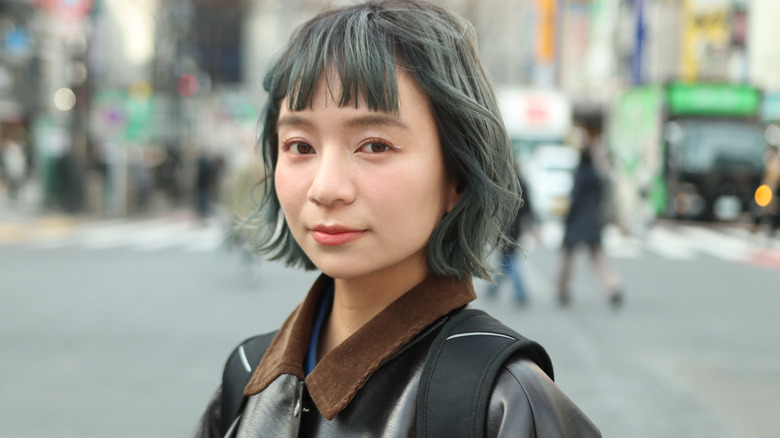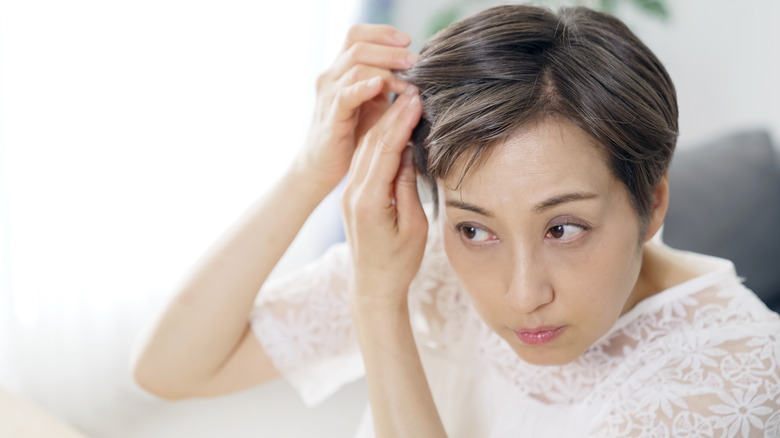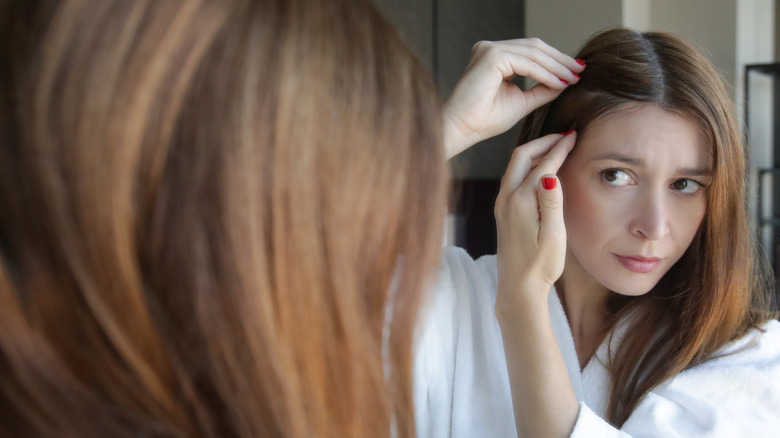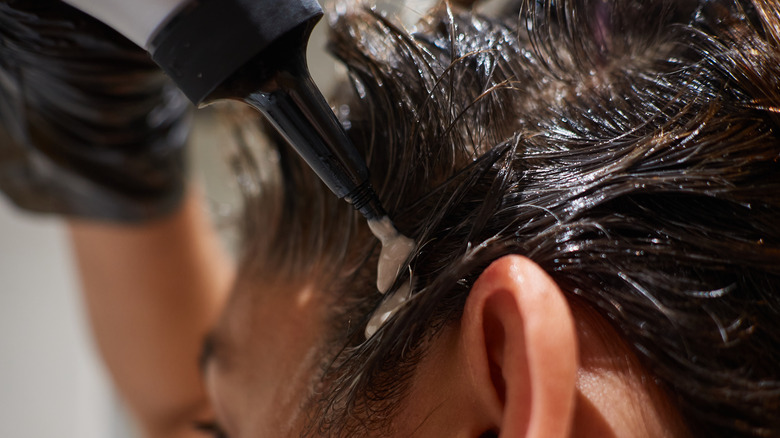Why Do Some People Go Gray In Their 20s?
When we think about getting gray hair, we usually don't picture ourselves having to deal with it until later in life. However, this isn't always the case. For some, gray hair can come as soon as their 20s. Even though gray hair is normal, it can be surprising to find yourself dealing with it sooner than you thought. As much as we would like to hold off until we are older, the natural color change can come at any age.
Hair turns gray when the strand loses melanin, explains the Cleveland Clinic. The hair loses melanin due to a loss of melanin-producing stem cells. The process of losing these stem cells typically happens at an older age. However, there are plenty of reasons why your gray hair might begin showing up at an earlier age, so let's break down the most common ones, as well as how you can handle gray hair in your 20s.
Genetics
One of the biggest factors behind premature gray hair? Genetics. Unfortunately, there's not much you can do if you inherit genes that predispose you to early grays. Although scientists are still researching the exact relationship between genetics and gray hair, it's fairly obvious if this trait runs in your family. For example, your mother or father may have been gray your entire life — and chances are, they likely started seeing their first silver hairs around the same age you did.
At the time of writing, there are several scientists seeking to find answers about the genetic link to premature graying. According to a study published in the scientific journal Nature, the cause of gray hair could be related to malfunctioning melanocytes, a type of stem cell that gives hair its color. The theory is that young melanocytes never fully develop, leaving the hair devoid of pigment. While more information is needed to understand the greying process, researchers indicate that there may be an opportunity to reverse it in the future. In the meantime, those with genetically-predisposed pigment loss can learn to love their grays or experiment with hair color.
Stress
Few things in life are quite as irritating as stress. That's because stress begets stress, and high cortisol levels from stress can lead to numerous ailments, from dental decay to trouble sleeping. Now, you've probably heard an older relative joke that your youthful antics were turning their hair white from stress. As it turns out, they may have been onto something.
That's right, stress is the gift that keeps on giving, as it's even responsible for some degree of premature grey hair growth. In another study published in Nature, scientists exposed lab mice to high levels of stress, uncovering that mice with dark fur turned white in a short period of time. Fur lightening in mice works similarly to humans, so it's safe to say that stress has damaging effects on the hair pigmentation of both species. The good news is that stress — for the most part — is a temporary condition that can be successfully managed. To keep your stress levels in check, you know the drill: sleep well, stay hydrated, opt for healthy snacks, and practice mindfulness — at least for a start. If your premature grays are stress-related, they should respond positively to healthy lifestyle changes.
Smoking
It's no secret that smoking isn't exactly great for your health. In addition to causing negative skin effects and nicotine-stained nails, smoking is also one of the biggest contributors to early graying. Research published in the medical journal Skin Appendage Disorders supports this fact, stating that premature graying and even hair loss are more common in smokers than non-smokers. Just like stress, smoking can alter the pigmentation of the hair, meaning that if you smoke, it's probably best to drop the habit to avoid premature grays.
While it's unclear whether quitting smoking can reverse gray hair growth, some say they've seen a reduction in grays after quitting. Ultimately, experts say that reversal is dependent on what caused the premature graying in the first place. "Once a person loses all their melanocytes, they would be unable to produce melanin and therefore their grey hair cannot be reversed," Lisa Tan, managing director of Ales Group Singapore, tells Channel News Asia. Even if it doesn't fully restore color to the roots, making the decision to quit smoking is crucial to support other areas of one's health, too.
Autoimmune disease
Illnesses can have plenty of strange effects on our bodies. With viral infections, for example, you might notice you've suddenly lost your sense of taste or smell. Autoimmune diseases are thought to be on the rise in the United States and can include conditions such as lupus, Crohn's disease, and type 1 diabetes. Another unique trait that comes from having an autoimmune disease? You may be more prone to developing premature grays.
Not every autoimmune condition causes gray hair in younger people, but researchers have identified a few illnesses that can be responsible for silver locks. A study published in the International Journal of Trichology noted that vitiligo, pernicious anemia, and some thyroid conditions could play a role in the process of going gray prematurely. Plus, researchers also found that low vitamin D levels could contribute to the formation of early gray hair growth. Much of what we know about autoimmune disorders and gray hair has been discovered fairly recently, and we may learn more about the nature of their relationship in the future.
How to deal with gray hair in your 20s
If having gray hair is causing you too much stress, know you can deal with it without too much hassle. L'Oréal Paris suggests using a root spray to conceal any roots that are beginning to appear gray. If all of your gray hair concentrates in the roots, a root spray can be a quick and inexpensive solution for a quick cover-up. A root spray, along with powders and pens, is a portable way to cover up those gray hairs while you are on the go. If you want a more permanent solution, try to conceal some of the future gray hairs with highlights or lowlights. Experimenting with highlights is one way to blend in the silver streaks as they start popping out.
The experts at Sally Beauty add that at-home dye is another approach to covering any gray hair. Whether you go for a premium or an affordable one, at-home dyes are ideal if you need to cover a bigger section of hair at a moment's notice. However, the easiest way you can deal with gray hair is by simply letting it grow. Nowadays, more people are choosing colors, like gray, white, and silver, as part of a growing beauty trend. Even if your gray hair is natural, it's part of a style many would love to rock. Embracing gray hair might not come right away, however, it is the cheapest and most liberating option.





